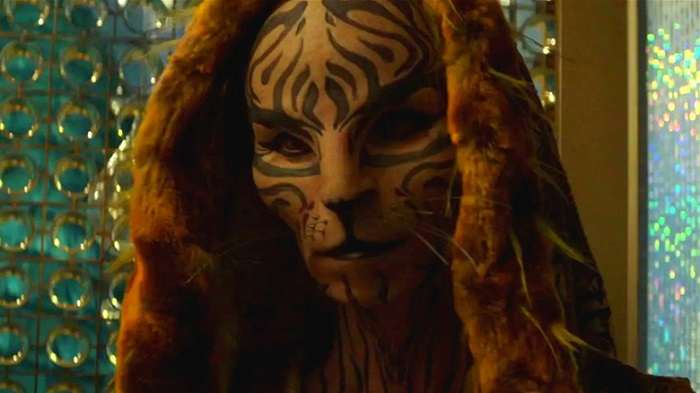This article delves into the life and symbolism of Tigris Snow, exploring her backstory, her transformation from Capitol stylist to a rebel sympathizer, and her role in the Hunger Games universe. We’ll also explore the significant themes of identity, survival, and betrayal that surround her character.
Who is Tigris Snow?

Tigris is first introduced in Mockingjay as a former stylist for the Hunger Games, now working as a shopkeeper in the Capitol. Her boutique specializes in animalistic fashion, with her own appearance heavily altered to resemble a tiger. With her surgically modified face, feline features, and penchant for animal-themed clothing, she stands out even in the extravagant world of the Capitol. However, Tigris’s appearance isn’t the only thing that sets her apart — it’s her quiet defiance against the very system that once made her.
The Snow Connection
Tigris is revealed to be related to President Coriolanus Snow, the ruthless leader of Panem. In The Ballad of Songbirds and Snakes, a prequel to The Hunger Games, we learn that Tigris is Snow’s cousin, and the two share a complicated bond. As children, they lived together in a once-wealthy family that had fallen on hard times. The young Tigris had dreams of becoming a renowned Capitol stylist, while Coriolanus was groomed for political power.
Despite the close relationship they had as children, by the time of the original Hunger Games trilogy, Tigris harbors resentment toward her cousin. Her transformation, both physical and emotional, reflects her rejection of the Capitol’s cruelty and her disillusionment with Snow’s regime. She becomes a quiet symbol of rebellion, offering refuge to Katniss Everdeen and her team during their final mission to assassinate Snow.
Tigris’s Role in Mockingjay
Aiding the Rebellion
When Katniss and her team arrive in the Capitol in Mockingjay, they are in desperate need of a safe place to hide. It’s here that Tigris’s character takes on a crucial role. Once a celebrated Capitol stylist, she now runs a small shop selling fur garments, far removed from the glamorous world of the Hunger Games. Tigris offers the rebels sanctuary in her basement, risking her life to protect them from the Capitol forces.
Her willingness to help the rebellion signifies her deep disillusionment with the Capitol and her cousin, President Snow. Tigris’s store, located in one of the seedier districts of the Capitol, becomes a symbol of the underbelly of Panem’s society — the place where those who have been cast aside by the Capitol’s elite are left to survive.
Transformation into a Symbol of Defiance
Tigris’s physical transformation into a feline-like figure is not just a fashion statement. Her surgically altered features and animalistic appearance are a metaphor for her rejection of the Capitol’s shallow beauty standards and its dehumanizing values. By taking on the features of a tiger, Tigris embraces the natural world and rejects the artificiality of the Capitol.
Her shop, filled with furs and animalistic designs, serves as a stark contrast to the sterile, technologically advanced world of the Capitol. It’s a space where the natural and the human can coexist, a sanctuary for those who have been broken by the Hunger Games.
Tigris in The Ballad of Songbirds and Snakes
Tigris’s backstory is expanded upon in The Ballad of Songbirds and Snakes, which takes place during the 10th Hunger Games. In this prequel, we see a younger Tigris, before her radical transformation, when she is still hopeful and idealistic. She is a talented apprentice stylist, working alongside her cousin Coriolanus, who is struggling to maintain his family’s dignity in the face of poverty.
The Early Days of the Hunger Games
In the early days of the Hunger Games, the Capitol’s cruelty is still evolving. The Games are far less extravagant, and the tributes are treated with even less regard than they are in the later installments. Tigris plays a role in designing the appearances of the tributes, though her work is not yet celebrated.
Through Tigris’s eyes, we witness the Capitol’s growing obsession with control and spectacle, which ultimately leads to the horrifying version of the Games we see in Katniss’s time. Tigris’s participation in the early stages of the Games is marked by her gradual disillusionment. She begins to see the Capitol’s cruelty for what it is, and though she remains loyal to her cousin, the seeds of her eventual rebellion are planted.
The Snow Family Dynamics
Tigris and Coriolanus share a complicated familial relationship. While they care for each other deeply as children, the growing ambitions of Coriolanus and his eventual rise to power drive a wedge between them. Tigris, who once admired her cousin, becomes increasingly disturbed by his ruthlessness and willingness to sacrifice others for his own gain.
In The Ballad of Songbirds and Snakes, we see the beginnings of the moral divide that will ultimately sever their relationship. Tigris, though not as politically ambitious as her cousin, possesses a deep sense of empathy and compassion, qualities that Snow views as weaknesses. As Coriolanus becomes more entrenched in the Capitol’s power structure, Tigris is left behind, both literally and metaphorically. By the time of Mockingjay, their relationship is all but shattered.
Tigris as a Symbol of Survival
One of the key themes that Tigris embodies is survival. Like many characters in The Hunger Games, Tigris is a survivor of a brutal system that seeks to destroy those who do not conform. Her physical transformation into a tiger-like figure is not just a rebellion against the Capitol’s ideals of beauty but also a means of survival in a society that values appearances above all else.
Tigris’s survival also reflects the broader theme of resilience in the face of oppression. She survives not just the physical hardships of life in the Capitol’s underbelly but also the emotional toll of being cast aside by her cousin and her society. Her ability to endure and ultimately aid the rebellion speaks to her strength and resourcefulness.
The Hunger Games and the Theme of Identity

Tigris’s character also raises important questions about identity in The Hunger Games. In a society where appearances are everything, Tigris’s transformation is both a statement of individuality and a form of self-preservation. She alters her appearance to such an extent that she becomes almost unrecognizable, a reflection of the way the Capitol dehumanizes its citizens.
Her animalistic features serve as a reminder of the Capitol’s obsession with control over the body and the mind. Yet, by choosing to resemble a tiger, an animal known for its strength and independence, Tigris asserts her own identity in the face of a society that seeks to erase individuality.
Betrayal and Redemption
One of the most poignant aspects of Tigris’s character is her sense of betrayal. She is betrayed by her cousin, who values power over family, and by the Capitol, which discards her once she is no longer useful. Her physical transformation into a tiger is a visual representation of this betrayal — she has been changed beyond recognition by the society that once celebrated her.
Yet, Tigris finds redemption in her act of defiance. By helping Katniss and the rebels, she takes a stand against the very system that betrayed her. In doing so, she redeems herself, not just in the eyes of the rebels but also in her own eyes. Her quiet rebellion is a powerful statement about the importance of standing up for what is right, even in the face of overwhelming odds.
Related Post:
Al Hilal SFC Games: A Deep Dive into the Thrilling World of Saudi Arabian Football
Christmas Games for Kids: Fun-Filled Festivities for the Holiday Season
Scary Games on Roblox: A Terrifying Adventure Awaits
Tigris Snow may not be the most prominent character in The Hunger Games, but her role is deeply symbolic. Her transformation from a Capitol stylist to a rebel sympathizer mirrors the larger themes of the series: the fight for survival, the quest for identity, and the consequences of betrayal. Through her story, we see the corrupting influence of the Capitol and the strength of those who choose to resist it.


